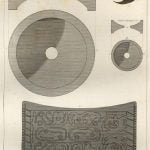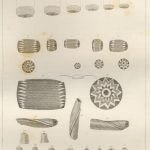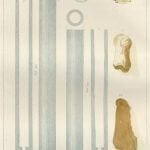
Charms for preventing or curing disease, or for protection against necromancy, were the common resort of the Indians; and they are still worn among the remote and less enlightened tribes. These charms were of various kinds; they were generally from the animal or mineral kingdom, such as bone, horn, claws, shells, steatites, or other stone of the magnesian family.
The Indian philosophy of medicine greatly favored this system of charms. A large part of their materia medica was subject to be applied through the instrumentality of amulets. They believed that the possession of certain articles about the person would render the body invulnerable; or that their power to prevail over an enemy was thus secured. A charmed weapon could not be turned aside. The possession of certain articles in the secret arcanum of the gush-ke-pi-tá-gun,11 or medicine sac, armed the individual with a new power; and this power was ever the greatest, when the possession of the articles was secret. Hence secresy in the use of their necromantic medicines was strictly enjoined. There was a class of charms that might be thrown at a person, and the very gesticulation, in these cases, was believed to be enough to secure efficacy. The mere thrusting of a Meda s sac towards an individual was deemed to be efficacious. A beam of light was often sufficient, in the Indian s eyes, to be charged with the fatal influence. Where the doctrine of necromancy is believed, it is impossible to limit it, and the Medas, who had learned their arts from regular profession in the secret chamber of the mystical lodge, formed a class of persons of whom the common people were in perpetual fear. The term medäëka, which is applied to this class of things, relates to any article worn openly, or concealed about the person, to which the doctrine of medical magic might be applied.


The variety of articles actually worn to ward off evil influences was very great. Some form of a seashell, manufactured or unmanufactured, was regarded as a common protective, or amulet, by most of the tribes. This passion for shells from the sea was peculiar. The sea appears to have been invested with mystical powers. It was regarded as one of the most magnificent displays of the power of the Great Spirit or Deity, and a product rolled up from its depths, colored and glittering, as the nacre of oceanic shells, was regarded as bearing some of this great mysterious power. The venus mercatorius was thus prized, and various articles of ornament, which they deemed sacred, were made from them. Such were the ancient and the modern wampum, strings of which were worn about the neck, and delivered as mementoes at the ratification of their most solemn covenants.
Eardrops and nose-drops were anciently made from shells, and they were worn, not merely as ornaments, but as protective. A necklace of the claws of the grizzly or black bear, was supposed to impart some of the powers of the animal. The red pipestone of the Coteau des Prairies was carved into various ornaments, and worn about the neck, or suspended from the ears. It is impossible to tell what form this desire might not take among a people whose superstitions were so varied and subtle.
Articles which had served the purpose of amulets in life were deposited in the tomb, for the Indian futurity is not a place of rest; and the hunter’s soul, in its uneasy wanderings, still had occasion for the protecting power of the charm. Hence, in opening ancient graves and tumuli, it is found that the amulets to which the deceased was attached in life were deposited with the body.

The subjoined specimens are given from the two periods of post and ante-Columbian antiquities. (Figs. 1, 2, 3, 4, 5, 9, 11, Plate 25.)
The antiques of this character, formed from the much-prized sedimentary red pipestone deposit of Minnesota, are figured in 7, 23, 25, 26, 27, and 28, Plate 25, together with amulets made from various kinds of stone or bone. In Figures 8, 10, 13, 14, 15, 16, 17, 18, 19, 20, 21, 22, and 23, Plate 25, and Figures 7, 8, 9, 10, and 11, Plate 24, we observe the change which this passion underwent among the tribes, on the introduction of various shaped beads of glass and coarse enamel by Europeans, at, and after, the opening of the 16th century. Farther evidences of this kind are observed in Figures 1, 2, 3, and 4, Plate 32, under the guise of metallic rings, distributed by the early missionaries. These specimens were obtained in the area of the ancient French colonization, in Onondaga, New York.
